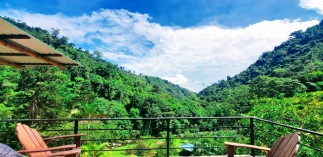High in the mountains of Costa Rica, our secluded retreat offers not just breathtaking vistas but glimpses of wildlife unlike any other. Today, we turn our gaze to a rather uncommon visitor to our tranquil lakes: the Eared Grebe (Podiceps nigricollis).
While not as frequently spotted as some of our resident birds, the Eared Grebe’s appearance is a delightful surprise. This medium-sized freshwater diving bird boasts a unique charm, with its sleek black plumage contrasting beautifully with its bright yellow eyes and – during breeding season – conspicuous golden “ear” tufts.
A Master of the Water
Eared Grebes are true masters of their aquatic domain. Their streamlined bodies and lobed feet propel them effortlessly across the water’s surface. Watch in awe as they gracefully glide, their necks held high, searching for prey. But don’t be fooled by their calm demeanor. When danger approaches, they can vanish in a blink, diving deep underwater with remarkable agility.
Their diet consists mainly of small fish, insects, and aquatic invertebrates. Their excellent eyesight allows them to spot prey from afar, and their sharp beaks make them efficient hunters.
A Solitary Soul (Except When It’s Not)
Eared Grebes are generally solitary birds, preferring to spend their days alone or in pairs. However, during breeding season, they can be quite social, forming small colonies on freshwater lakes. Their courtship displays are a sight to behold, involving elaborate head-bobbing, synchronized swimming, and the presentation of aquatic weeds as gifts.
The nest itself is a simple floating platform of vegetation, built near the water’s edge. Both parents take turns incubating the eggs and caring for the chicks after they hatch. These fuzzy bundles of fluff are adept swimmers from a young age, following their parents on foraging expeditions.
An Uncommon Visitor, But a Welcome Sight
The Eared Grebe’s presence in the highlands of Costa Rica is uncommon, with sightings primarily documented in the lowlands and along the coasts. However, their occasional stopovers at our mountain lakes are a testament to the rich biodiversity that flourishes in our protected environment.
So, the next time you’re enjoying the tranquility of our lakes, keep your eyes peeled for a flash of black and gold. A glimpse of the Eared Grebe, with its air of mystery and grace, is a truly special encounter to be cherished.
For more information, please view our comprehensive guide about the birds of Costa Rica







